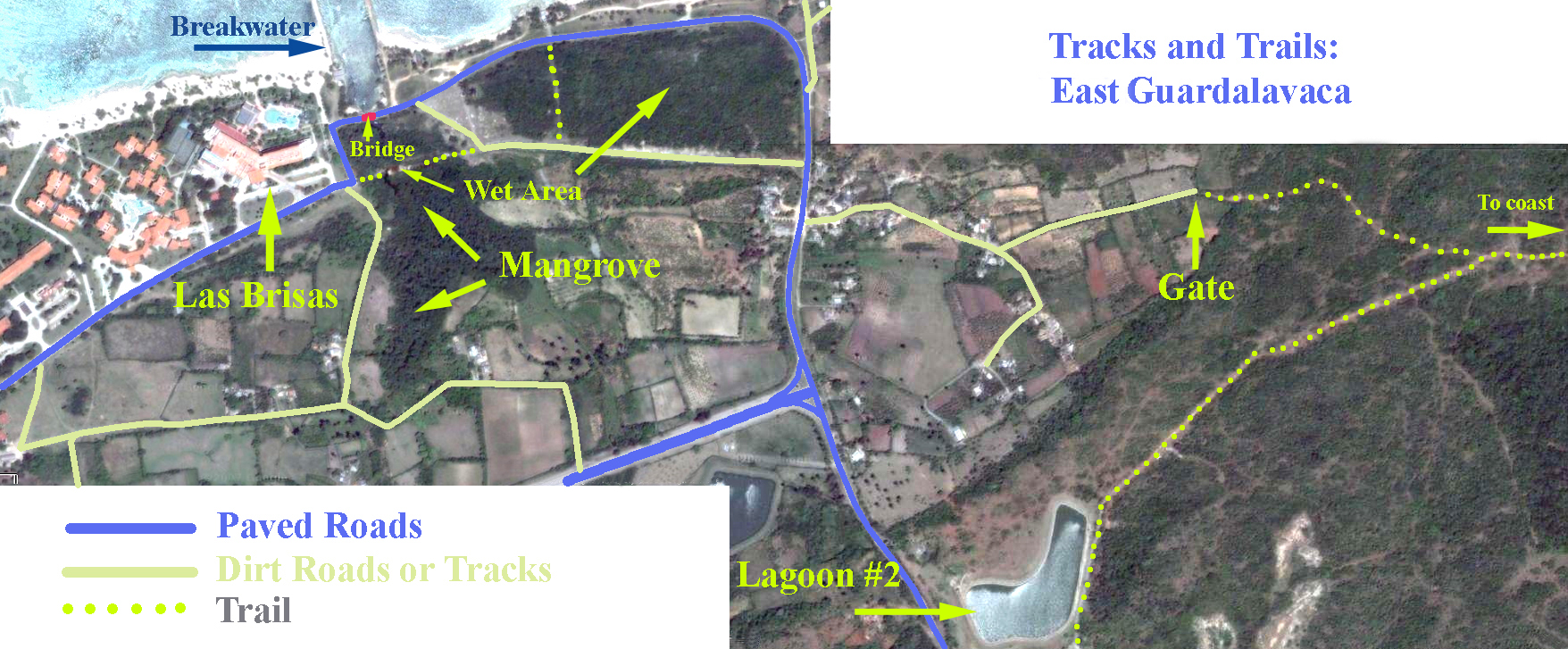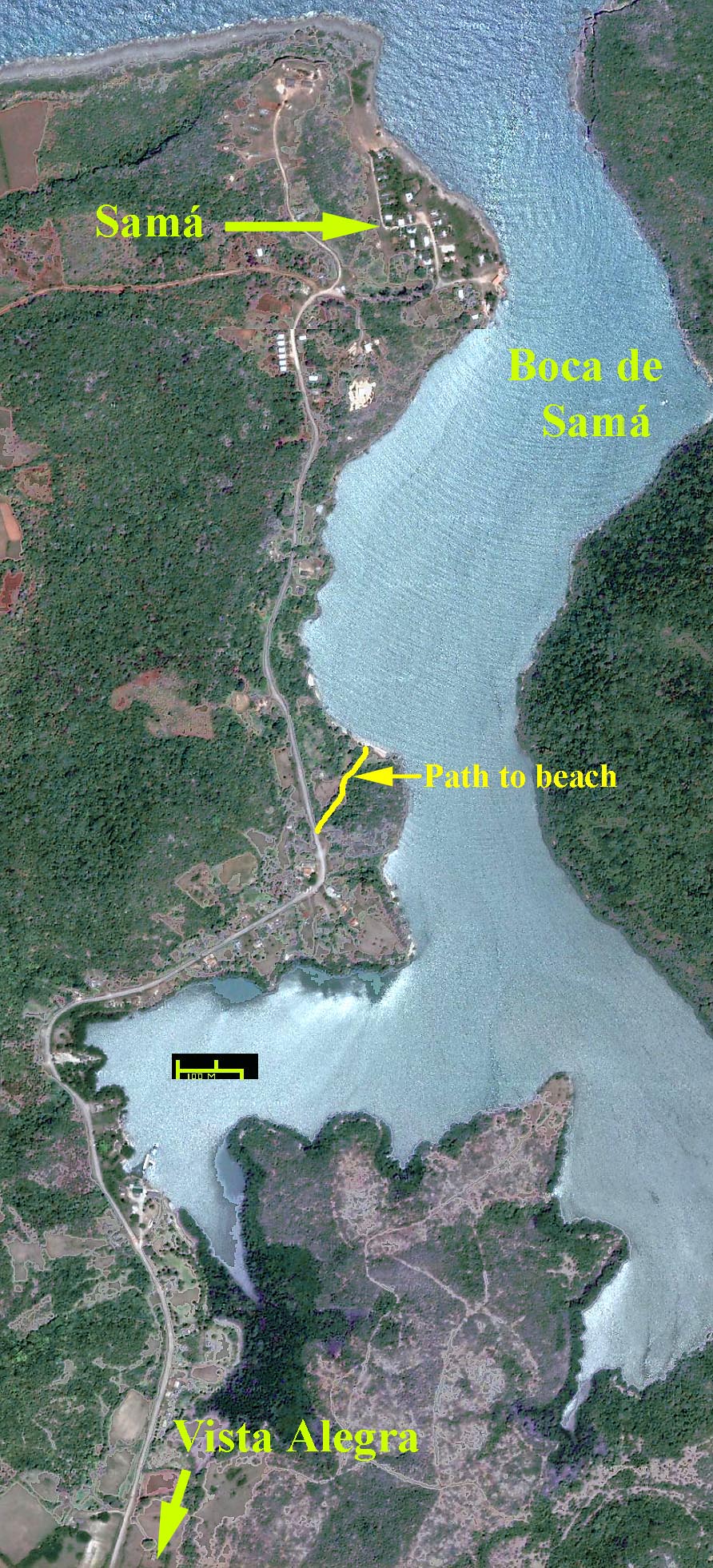Birding the Americas Trip
Report and Planning Repository
Return to the Main Index
Return to the North
America
Index
Return to the Caribbean
Index
Return to the Cuba Index
Birding Sites and Maps
Guardalavaca area,
Holguin Province, Cuba
Introduction
Many package tours go to the Guardalavaca area of Holguin
Province, Cuba, and I have been fortunate enough to go to Las Brisas,
Guardalavaca, on four occasions between 1998 and 2010.
There are trip reports for the 1998 and 2000 trips (though not for
2003), and not yet for 2010. The earlier reports are still
accurate, but some sites mentioned were seriously impacted by a
hurricane in 2007.
Here is a quick visual overview of the area covered by this article
(and many, but not all, are mentioned in the earlier trip
reports). We'll start with an overview map.
Map #1 -
Guardalavaca Overview
On the map below it is roughly 10 km in a
straight line from Bahia
de Naranjo (in the west)
to Boca de Sama (in the east), though the roads take a more indirect
route.
The Playa Turquesa resort area (just off the map) lies along the
coastline immediately to the west of Parc Nacional Bahia de Naranjo,
and the more heavily developed Playa Pesquero is to the west further
still, roughly 4 km as the Cuban Blackbird flies. Resorts at both
these Playas offer daily shuttles to Guardalavaca, as it is the main
shopping centre for this tourist area.
Next: a close-up of the western
half of the above map.
Map #2 -
Playa Esmerelda to Guardalavaca
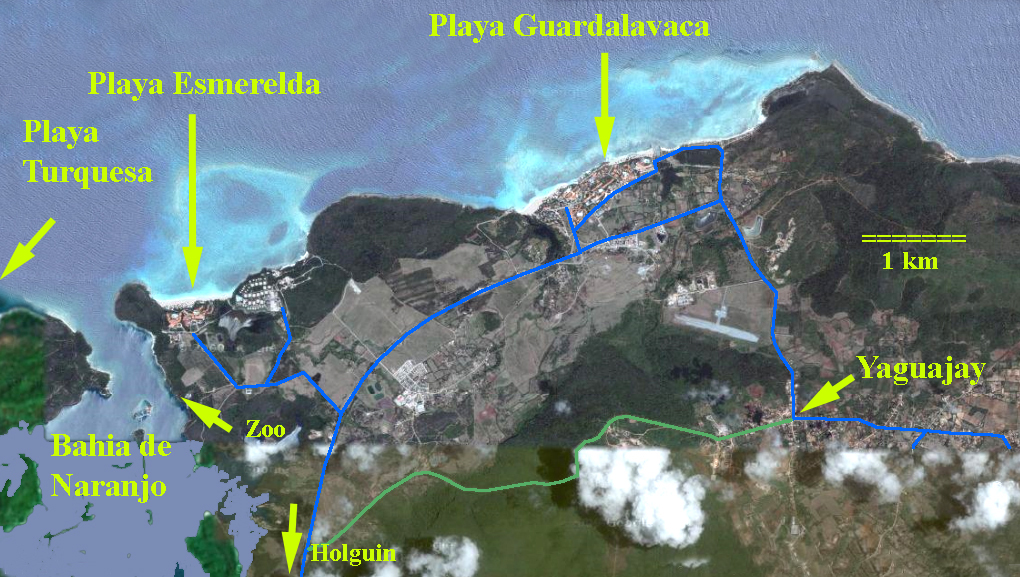
The dark blue lines indicate main paved roads. The green
route running
west from Yaguajay is untested, but said to be navigable. The next
series of maps (Maps #3 - #8) provide close-ups of this area, roughly
west to east.
Map #3 -
Playa Esmerelda area
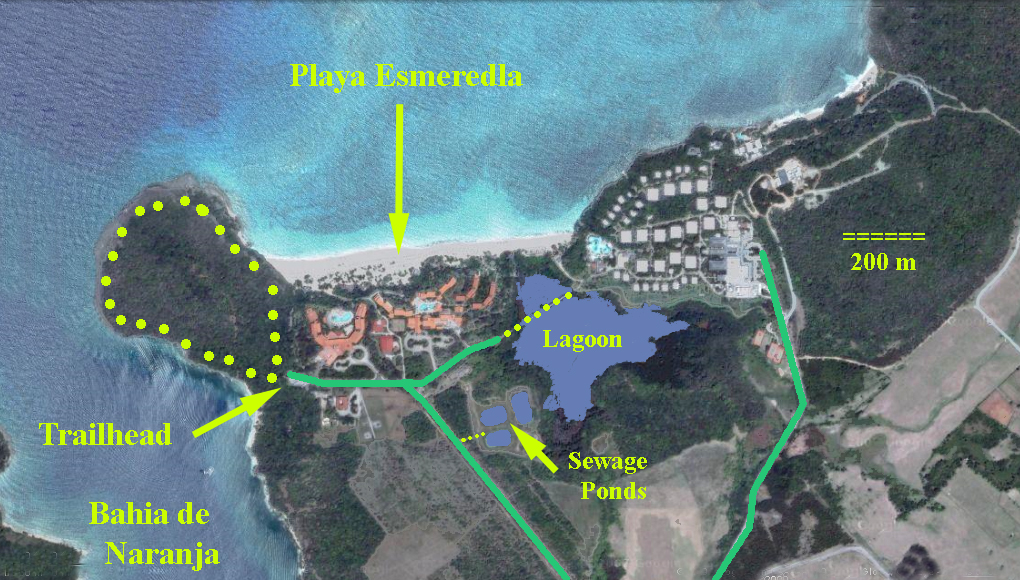
There is a well-maintained trail to the east of the Playa, but an
entrance fee is charged. An unofficial track leads south along
the east shore of Bahia de Naranja from the trailhead, accessible by an
obvious unmarked path. This path goes as far as the zoo, which is
otherwise accessible off the access road to the Playa Esmerelda resorts.
The trail, the sewage ponds, and the lagoon can be visited by anyone,
not just guests of the three resorts in this area.
There is a forested area to the east of the eastern-most resort,
accessible via a dirt track to the right, roughly 250 metres before the
end of the resort access road (marked in green).
Map #4 -
Guardalavaca Village Area
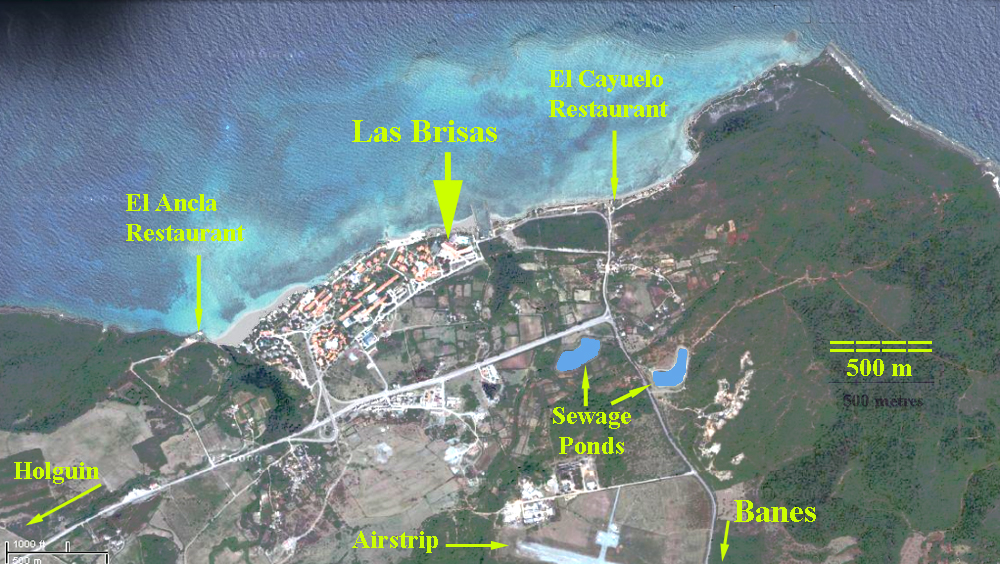
This is an overview of the Guardalavaca Village area. The
resorts in the village are all operated by the Cuban Government, and
the largest is Las Brisas (including Villas Las Brisas), at the eastern
end of the village. The next series of maps
(Maps #5 - 8) zoom in on various parts of the Guardalavaca Village
area. We start west, and go east.
Map #5 -
West End of Guardalavaca Village
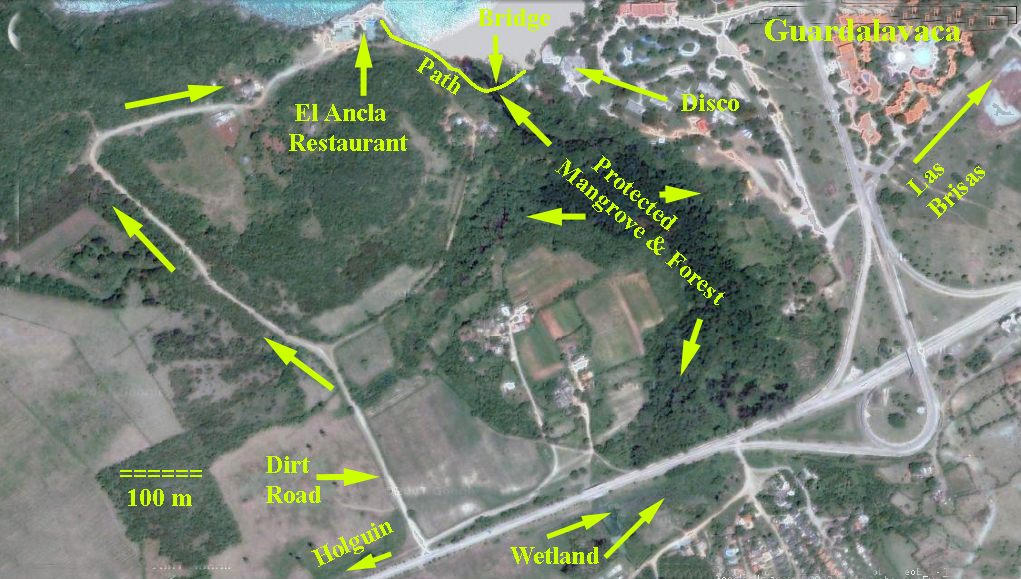
A path runs along the edge of the beach between the El Ancla
Restaurant and the west end of Guardalavaca Village. The
path
crosses
the north end of the mangrove on a pedestrian
bridge. Stairs lead up from the path behind a Surf
Hut, up to the public Disco. The mangrove, and the forest
surrounding it, were both badly damaged in the 2007 hurricane, but the
site remains a key spot. Mangrove Cuckoos are present, but very
elusive. This site should improve as vegetation grows
back in.
On the south side of the main road leading to Holguin, just west of the
interchange, there is an extensive wet area, easily viewable from the
road, which can be productive if
there is sufficient water.
The fields and forest adjacent to the dirt road leading to the El Ancla
Restaurant are often worthwhile, and there are many side tracks and
paths into the forested areas.
Map #6 -
East End of Guardalavaca Village
The 2007 hurricane tore up the lovely mangrove that lies just east
of Las Brisas. It also destroyed the western end of path that led
east from the sharp turn in the paved road (at the east end of Las
Brisas). The mangrove is still worth a lot of your time, as it is
utilised by many wintering neotropical migrants, and resident birds as
well. Migrants and resident birds are also found in the hedgerows
that border farmers' fields, best accessed by walking the tracks that
extend south of the paved main access road to the village. This
map also shows a nice loop route to the east of the paved road running
south from the eastern end of Playa Guardalavaca (at the El Cayuelo
Restaurant) south to Banes. This is not in any sense a marked
trail, but the route is easy to follow. Next: the sewage lagoons.
Map #7 -
Guardalavaca Village Sewage Lagoons
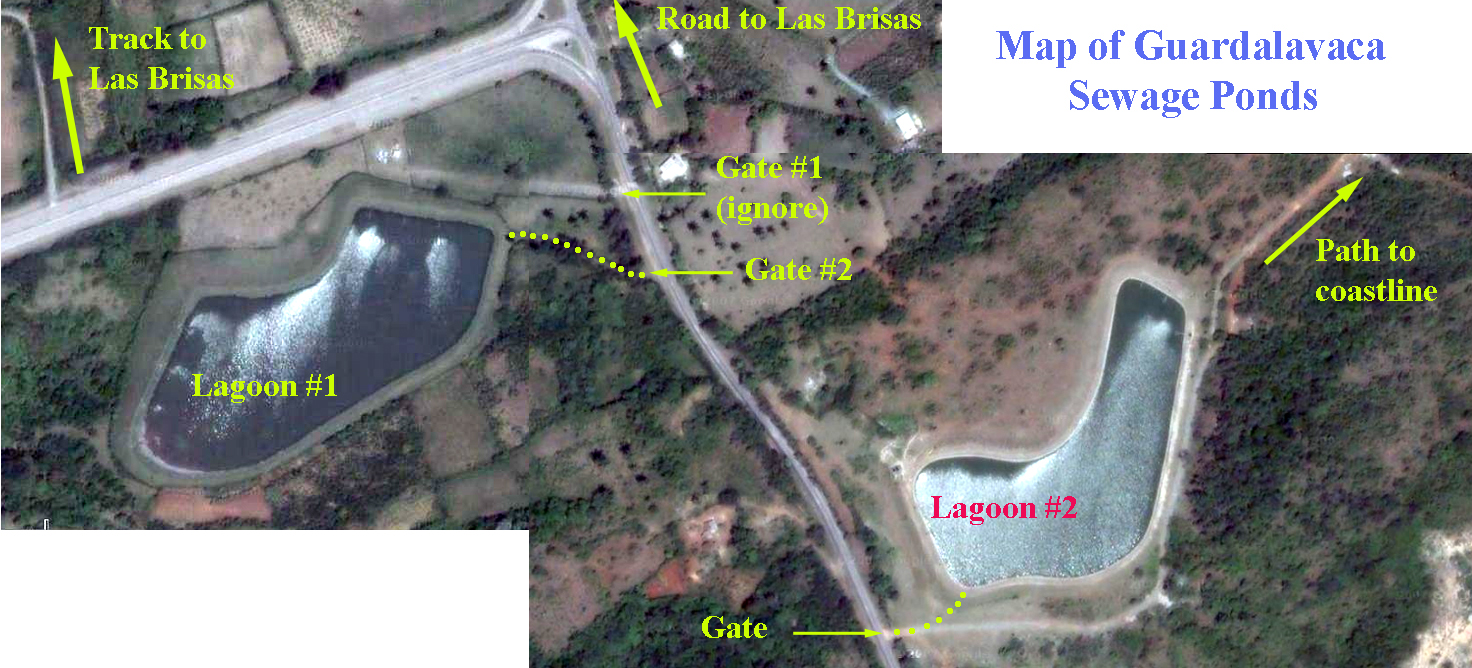
As these two sewage lagoon settling ponds are the only open
"fresh" water in the area, they are a required stop on any birding
exploration. The water surface of neither lagoon is visible from
the roads -- you have to walk onto the lagoon dykes, and observe from
there. There have not been too many reports from the lagoons,
so surprises await, but in winter you can expect Least Grebes, Ruddy
Ducks, and various overwintering waders. There is some movement
of birds between the two lagoons.
The northern gate to the east of Lagoon #1 leads to the lagoon
water-control huts, and access to the dykes is awkward, though not
impossible. Better by far is to use the southern gate, which
leads directly onto the dykes, along a productive lane lined with
hedgerows and trees.
After birding Lagoon #2 you can hike the trail leading NE, which ends
up eventually at the Coastal Trail, or you can go left at the first
crossroads to return west through a farm area to the paved road leading
to Guardalavaca Village. These options are more clearly
illustrated on the next map.
Map
#8 - Guardalavaca Coastal Trail

This trail offers a wonderful way to spend a morning, or a full
day. I recommend that you hike the trail counter-clockwise, as it
is unmarked, and when hiking clockwise on the trail along the
coastline, you might miss the trail leading SW to Sewage Lagoon
#2.
It is possible, once you reach the coastline, to hike SE roughly 3 km
along the coast to the western mouth of Boca de Samá (see map
#9, following), though it is best to avoid the Cuban Coast Guard
Station situated at the western mouth.
The Coastal loop trail portayed above rings a relatively undeveloped
forested area, though most of the larger trees were lost in the 2007
hurricane. There were many side trails through the forest but
these are now mostly impassable, again because of the storm. It
is worthwhile to venture into the forest for short distances to improve
your chances of encountering different species, but take care if not on
an obvious path (though the sound of the surf is a good guide back to
the shoreline).
The NW end of the trail is located along the shoreline at the east end
of a row of private homes that extend east of La Cayuelo
Restaurant.
Map
#9 - Guardalavaca to Boca de Samá
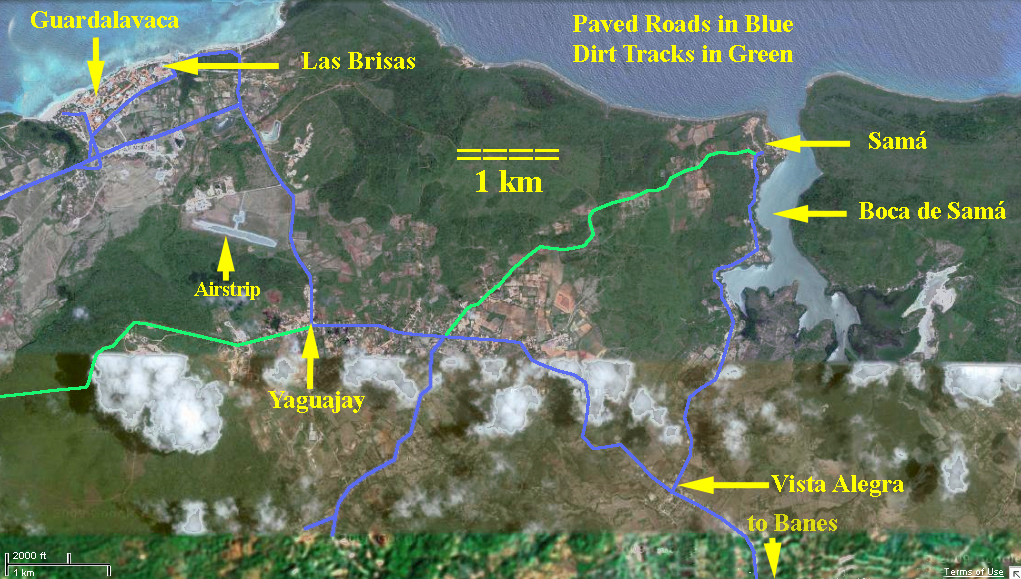
The blue lines on the above map indicate paved roads, in
particular the main road linking Guardalavaca with Banes. If you
have the energy all these road are best explored with a bicycle, though
one could certainly hike the road south of Guardalavaca to Yaguajay,
and then west to the highway between Holguin and Guardalavaca -- the
junction, indicated on Map #2, is 1 km south of the turnoff to Playa
Esmerelda.
The paved road leading south of the road between Yaguajay and Vista
Alegra leads to the Historic Indian Village, to which all the resorts
offer tours. I've not cycled this road (it was quite hilly), but
it could prove productive.
There are grassy fields between the airstrip and the airstrip access
road (north of the airstrip), and Eastern Meadowlarks are resident
here. This subspecies,
one of two in Cuba, is very much overdue for a split. Indeed,
they both are.
On satellite images (from which there maps were created) there is a
visible track running SW from the village of Samá to the road
between Yaguajay and Vista Alegra: it joins just east of the junction
for the road to the Indian Village. I have not yet hiked
this road, but it looks promising, passing through both forest and
agricultural areas.
On our last trip we did explore the Boca de Samá, and so we go
to Map #10.
Map
#10 -- Boca de Samá
It is a bit less than 5 km between the village of Samá (at
the western mouth of Boca de Samá), and the village of Vista
Alegra, on the road between Guardalavaca and Banes. It is a
worthwhile walk or bicycle (or get dropped off and picked up by taxi),
as the patches of forests here better survived the hurricane, and there
are terns, gull, and herons along the Boca -- and, at times, many
touristas, on boat tours or horrid jet skis. A public trail to a
beach is indicated on the map above.
It is a pity that
there is no obvious access to the SE arm of the Boca, as it is shallow,
and reveals many mudflats at low tide, which herons and waders
enjoy. If you look carefully at Map #9 you can see a track
leading to the middle of the NE shore of this arm, but I have yet to
determine how to access this track. For now it is necessary to
scope the arm at low tide from the road opposite, or pay a local
fisherman to take you in at mid-tide.
I hope you find these orientation maps useful, and welcome any
corrections or updates.
Safe travels.
Blake Maybank
Nova Scotia, Canada
http://flickr.com/photos/blakemaybank






